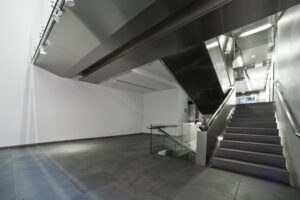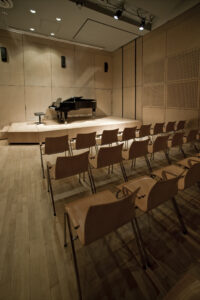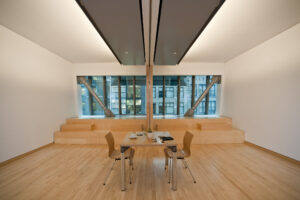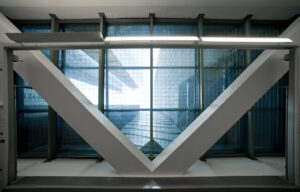Occupying the diminutive (25 feet wide by 81 feet deep) mid-block site of the Austrian Cultural Forum’s former townhouse, the new building rises to a 24-story height with the authority of a landmark, expressing the contextual relevance of both the architecture and the Forum’s mission to connect European and American creative visions.
Concentrated Austrian Creativity
Peter Marboe, a fierce proponent of the new building for the Austrian Cultural Forum, explains the reasons behind the decision to make an architectural statement in New York.
“The idea to construct a new building first came up in the mid-1980s. Back then we would sit at our desks with no heat in the winter and no air conditioning in the summer. The friendly little building was in need of a very costly full-scale renovation, but it would have neither gained us any space nor allowed us to communicate a symbolic message of creativity.
This, however, is precisely what then Foreign Minister Alois Mock wanted to achieve. The idea was to make an architectural statement in New York and in so doing take advantage of the opportunity to secure a leading edge. After all, when it comes to the arts and culture, Austria is one of the major players, and contemporary culture in particular plays a prominent role in the perception of the country by the media and the public.
Finally, after many years, and later with the unanimous approval of the Austrian Parliament, a resolution was adopted to build a fantastic new home for the then Cultural Institute on 52nd Street. All Austrian and expat Austrian architects were to be given a chance to participate, so the largest public competition in the country’s history was launched. Anyone who saw the 226 (!) models on display in the Messepalast (now the MuseumsQuartier) will never be able to forget the impression of concentrated Austrian creativity.”
The Austrian Cultural Forum tower in midtown Manhattan provides a state-of-the art home for an institution devoted to international cultural exchange. The building is the first major United States project for Austrian-born New York architect Raimund Abraham, whose design was selected in an open competition hosted by the Republic of Austria from among 226 participating architects in 1992. Facilities of the Forum tower include exhibition galleries; a flexible theater for performances, screenings, and lectures; a library; loft-like presentation areas and seminar rooms; reception and meeting spaces; staff offices; a multi-level residence for the Forum’s director; and an open-air loggia at the tower’s pinnacle. Occupying the diminutive (25 feet wide by 81 feet deep) mid-block site of the institution’s former townhouse, the new building rises to a 24-story height with the authority of a landmark, expressing the contextual relevance of both the architecture and the Forum’s mission to connect European and American creative visions.
Timeline
Construction commences: September 1998
Construction complete: January 2002
Dedication: April 18, 2002
Public Opening: April 19, 2002
Owner
Republic of Austria, Federal Ministry for European and International Affairs

The body of the Forum tower tapers as it rises, complying with zoning laws in levels that alternately step and slope. Glazed with dramatic glass panels that seem to be in a state of constant suspension, the forceful but mysterious image of the building has elicited comparisons to dagger blades and guillotines, thermometers and metronomes, Easter Island totems and pyramids of a future not yet imagined. The structure consists of what Abraham has dubbed “three elementary towers,” defined by the extreme conditions of a site only 25 feet wide and 81 feet deep: The Vertebra is the stair tower at the back of the site; the Core is the central structural tower containing the Forum’s functioning spaces within a meticulously constructed, interrelated arrangement; and the Mask is the glass articulation of the street facade, punctuated by a protruding, box-like volume that in fact accommodates an interior program area with spectacular views.

“This particular solution of a stair, which would satisfy the functional requirements as well as the directives of the building code, emerged as a result of a rigorous and sometimes agonizing process to arrive at a solution within the severely restrictive spatial conditions,” Abraham notes. “And at the same time this solution enabled me to transform an element of sheer utility into a decisive architectural component.”
The architect adds: “If there has been any inspiration or reflection upon a particular New York condition it was my fascination with the simplicity and surprising complexity of the scissor stair, which I believe was invented in New York City in the 19th century in courthouse designs in order to provide independent access and egress for prisoners, their captors, and their judges. Architecturally it has become the Vertebra of the Austrian Cultural Forum tower, striving for infinity as does the endless column of Brancusi.”

Upon entering this double-height entrance volume, visitors are drawn by the architecture itself into the heart of the building: The reception area flows along the bulge of a monumental stainless steel-clad drum (containing mechanical support for one of the building’s two elevators) directly into a New York bluestone-paved, floating stairway that both descends and ascends without interruption to connect public spaces of the Forum on five levels.
Moving down the floating stairs, visitors reach the Lower Mezzanine (an open area designed to accommodate exhibitions, installations, and other activities) and, further down the stairway, the Forum’s 1,600-square-foot Main Gallery on Level -1. Ascending the stairs from ground level visitors reach the Upper Mezzanine, another flexible program space that connects via a sleek Bridge to the Lounge level and, up another flight, to the Forum’s flexible, state-of-the-art 1,100-square-foot Theater.
Unifying all of these spaces is a grand 30-foot wall on the north side of the building’s interior, washed with natural daylight from a skylight inserted at the setback of the tower’s north facade. Through this skylight, visitors glimpse the soaring face of the structure’s back side — a rare view onto the poetic workings of architecture. “Light itself becomes the guiding factor in a visit to this building,” Abraham explains. “You enter from the light of outdoors and move toward light filtering at the back from the north facade. Because of this arrangement of space and structure, a visitor can visualize the entire experience from the moment he enters the building; his path is dictated by the stair, the flow of space. The building tells you where to go. It is radical because it uses a new approach to the classical idea of procession that has existed in public architecture since antiquity.”
The two below-grade levels of the Forum building contain mechanical support and storage (Level -2) and the Main Gallery (Level -1). The Main Gallery is an elegant, rectangular temperature- and humidity-controlled volume with bluestone floors and baseboards, a flexible cove and channel lighting system, and retractable projection equipment for screenings and special installations. At the north side of Level -1 are public restrooms and a catering kitchen adjacent to the elevator. At the south side of Level -1 is a concealed elevator to the sidewalk.




Levels 8, 9, and 10 are devoted to offices for the staff of the Austrian Cultural Forum. Spaces have been developed with an eye toward integrating both the open plan American-style office approach and the more European arrangement of work separate spaces. Floating walls of alternating transparent and translucent glass, bordered by brushed aluminum, define layers of space that are dedicated to group and individual offices while permitting maximum amounts of natural light to flow into all spaces from the monumental windows that front the south side of each floor.
Level 11 is fully occupied by a loft-like flexible space that will accommodate special performances, installations, seminar events, receptions and other activities of the Forum. “The loft allows us to do parallel programs that relate to the events and activities in some of the building’s more formal public spaces,” notes Thun-Hohenstein.
Level 12 houses the Forum’s computer server, mail room, and mechanical support for the smaller of the building’s two elevator shafts. Levels 13, 14, and 15 house storage and additional technical support spaces. Levels 16 through 19 accommodate the various functions of a residence for the Forum’s Director and his family, with dining/kitchen facilities, living room, master bedroom, family bedrooms, connected by a cylindrical, wood encased stairway.
Level 20 is occupied by an open-air Loggia, paved in bluestone. Here, the Forum is able to host special receptions in temperate weather, offering guests singular views West to the Hudson River and East across the urban canyon of buildings and streets.
Levels above 20 are devoted to technical functions, including machine rooms, a mechanical bulkhead, and the building’s water tower.
In summarizing the building he has designed and that has been so eagerly awaited by architecture aficionados, artists, and the public alike, Abraham is characteristically precise: “Architecture is the only discipline within the arts that has to confront itself with the issue of use. And there is not one formal decision in the Austrian Cultural Forum building that has not been contested with use. The use in this case is a very dense, complex program on a site where the space is compressed laterally by surrounding buildings — a compressed void. I had not only to confront use in terms of the zoning envelope, the general functions of a building, but also in dealing with gravity, with materials, with the physical world. As the architect you must translate your idea into a drawing, then into the physical world.”
The new Austrian Cultural Forum tower in midtown Manhattan provides a state-of-the art home for an institution devoted to international cultural exchange. The building is the first major United States project for Austrian-born New York architect Raimund Abraham, whose design was selected in an open competition hosted by the Republic of Austria from among 226 participating architects in 1992. Facilities of the Forum tower include exhibition galleries; a flexible theater for performances, screenings, and lectures; a library; loft-like presentation areas and seminar rooms; reception and meeting spaces; staff offices; a multi-level residence for the Forum’s director; and an open-air loggia at the tower’s pinnacle. Occupying the diminutive (25 feet wide by 81 feet deep) mid-block site of the institution’s former townhouse, the new building rises to a 24-story height with the authority of a landmark, expressing the contextual relevance of both the architecture and the Forum’s mission to connect European and American creative visions.
Location
11 East 52nd Street, between Fifth Avenue and Madison Avenue, New York City
Schedule
Construction commences: September 1998
Construction complete: January 2002
Dedication: April 18, 2002
Public Opening: April 19, 2002
Owner
Republic of Austria, Federal Ministry for European and International Affairs
Developer
Bundesimmobiliengesellschaft m.b.H. (BIG), Vienna, Austria
Dr. Hartwig A. Chromy, Managing Director
Dipl.-Ing. Gerhard A. Buresch, Managing Director
Developer Representative
Hanscomb Inc., New York, United States
Architect
Atelier Raimund Abraham, New York, United States
Raimund Abraham, Principal
Project Coordinators: Simone Giostra, Peter Leeb, John Veikos, Jeff Brown
Collaborators: Anders Abraham, Chris Barlieb, Jennifer Whitburn, Catherine Seavitt, Frank Thinius, Mike Derker, Maya Ballen
Engineers & Consultants
Ove Arup & Partners, New York, United States
Mahadev Raman, Principal in Charge
Project Manager: Steve Walker
Structural: Guy Nordensen, Dieter Feurich, Pete Tillson, Ricardo Pittella, Leo Argiris
Mechanical: Ray Quinn, Louis Arzano, Rebecca Welch, Greg Giammalvo, Fiona Cousins
Electrical: Tom Smith, Varughese Cherian, Peng Si
Drafting
Ash Chawal, John Giammundo, Sam Lee, John Miller, Goel Ramos, Margarita Guelova
Administration: Gina Wall, Tania Flavia
Plumbing and Fire Protection: Igor Kitagorsky
Construction Management
Barney Skanska Construction Co., New York, United States
Curtain Wall Consultant
RA Heintges Architects Consultants, New York, United States
Curtain Wall Manufacture
GIG Fassadenbau GmbH, Attnang-Puchheim, Austria
Site Dimensions
Width: 25 feet
Depth: 81 feet, 4 inches
Height
278 feet, 6 inches
Number of Floors
Below grade: 2 floors
Above grade: 24 floors (including roof terrace, mechanical and machine floors and water tank floor)
Floor Area
Gross: 33,000 square feet
Net: 24,850 square feet
Interior Breakdown (Major Features)
Lobby: 755 square feet
Gallery: 1,650 square feet
Lounge/CafZ: 413 square feet
Theater: 1,105 square feet
Library: 1,505 square feet
Communal Space: 800 square feet
Office Space: 2,770 square feet
Loft Space: 1,200 square feet
Residence Space: 5,490 square feet
Exterior Materials
Sub- and Superstructure: concrete with partial steelcrossbracing
South Elevation (facade): glass, steel and aluminum curtain wall
North, East and West Elevations: Rheinzinc panels and architectural concrete
Interior Finishes
Public Areas: bluestone pavers, ceramic tiles, painted gypsum board walls, brushed aluminum, stainless steel detailing, painted metal cladding and wood paneling
Offices and Private Residence: wood flooring, painted gypsum board walls, brushed aluminum and stainless steel detailing, painted metal cladding and glazed partitions
Elevators
2 electric traction elevators
1 sidewalk material elevator
HVAC
HVAC system uses floor-by-floor heat pumps for all levels above level 2.
Lower levels are conditioned using central air handling units, also incorporating heat pumps.
Modular boilers and cooling towers temper the heat pump loop.
Special use spaces include an acoustically sensitive theater and temperature- and humiditycontrolled art gallery.
Electrical Systems
High standard electrical systems include an emergency generator at the roof level, intrusion and access control, CCTV, audiovisual communications system, state-of-the-art communications network cabling systems.
Audiovisual and Acoustic Consultants
Ove Arup & Partners, New York, United States
Neill Woodger
Amir Yazdanniyaz
Teleplan, Vienna, Austria
Security Consultant
Ove Arup & Partners, New York, United States
Al Palumbo
Ron Ronnacher
Communications Consultant
Ove Arup & Partners, New York, United States
Al Lyons
Vadim Ovchinnikov
Furnishings
Atelier Raimund Abraham, New York, United States
Project Coordinator: Roland Eckl
List Möbelwerk GmbH, Olbersdorf, Austria
World Audio Visual Enterprises (WAVE), Mountainside, New Jersey, United States
Photography
David Sundberg, Esto Photographics, New York, United States
Publications
Bliem, E., ed. Austrian Cultural Institute, New York: An Architectural Competition. Innsbruck: Haymon-Verlag, 1993
Manhattan/Austria: The Architecture of the Austrian Cultural Institute by Raimund Abraham, published by Architektur Zentrum Wien with Verlag Anton Pustet, 1999
Seidl, W.: Zwischen Kultur und Culture. Das Austrian Institute in New York und Österreichs kulturelle Repräsentanz in den USA. Vienna: Böhlau Verlag, 2001
Kunsthaus Bregenz, archiv kunst architektur, Schneider, E., ed. Raimund Abraham. The Austrian Cultural Forum, New York. Ostfildern: Hatje Cantz, 2005
Lepik, A., Stadler, A., ed. Raimund Abraham & The Austrian Cultural Forum NY. Ostfildern: Hatje Cantz, 2010
A PDF Version of the fact sheet may be downloaded here
“Raimund Abraham & The Austrian Cultural Forum New York” published by Hatje Cantz, Berlin.
Architectural historian Kenneth Frampton called the Austrian Cultural Forum, designed by Austrian architect and theorist Raimund Abraham (1933–2010), the most spectacular modern structure built in New York since the Seagram Building and Frank Lloyd Wright’s Guggenheim Museum. With a width of 7.6 meters and a depth of 25 meters (25 feet wide by 81 feet deep), the 24-story tower with its symmetrical glass façade fits perfectly into Manhattan’s 52nd Street. Despite the extremely narrow plot of land, Abraham succeeded in producing extraordinary stylistic elements that elude any architectural trend.
This is the first monograph on the building after eight years of vigorous use, and numerous photos and multi-faceted material present the various features of the structure. Contributions on the significance of the institution in Austria’s domestic and foreign policy, on Abraham’s work, his stance as a teacher and theorist, his relationship to Austria, as well as on other aspects provide insight into his architectural and aesthetic ideas.
Edited by Andreas Stadler and Andres Lepik
Photographs by David Plakke, Robert Polidori
Texts by Peter Engelmann, Kenneth Frampton, Andres Lepik, Peter Marboe, Gerald Matt, Andreas Stadler, Lebbeus Woods
Layout and design by Verena Gerlach
German/English
2010. 128 pp., 86 color ills. and drawings
21.90 x 21.70 cm
hardcover
ISBN 978-3-7757-2725-9
The book is available online at amazon.com and hatjecantz.de or at the following New York booksellers:
Archivia Books
993 Lexington Avenue
New York, NY 10021
Tel. 212 570 9565
http://www.archiviabooks.com/
Book Culture
536 West 112th Street
New York, NY 10025
Tel. 212 865 1588
http://www.bookculture.com/
McNally Jackson
52 Prince Street
New York City, NY 10012 (map)
Tel. 212 274 1160
http://mcnallyjackson.com/
Rizzoli Bookstore
31 West 57th Street
New York, NY 10019
Tel. 212 759 2424
http://www.rizzoliusa.com/bookstore/
Strand Book Store
828 Broadway
New York NY 10003
Tel. 212 473 1452
http://www.strandbooks.com/



